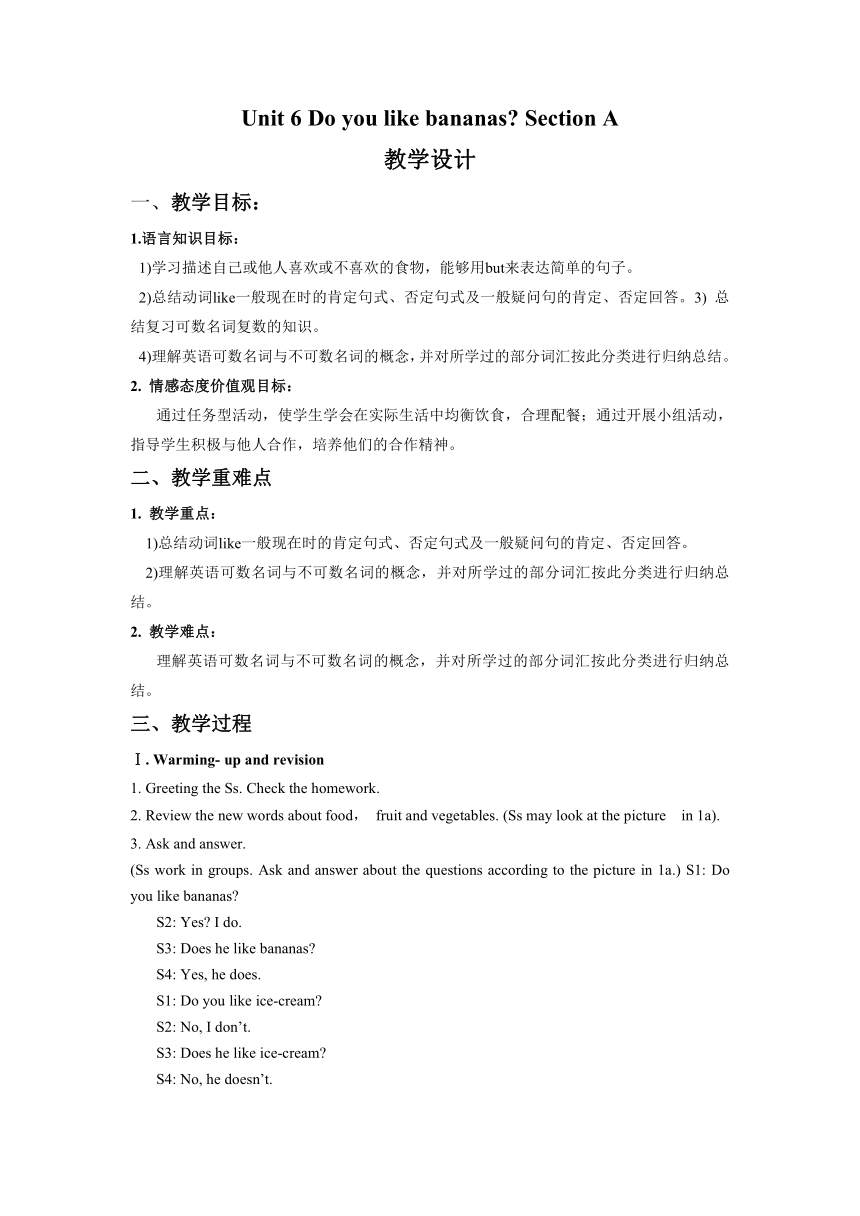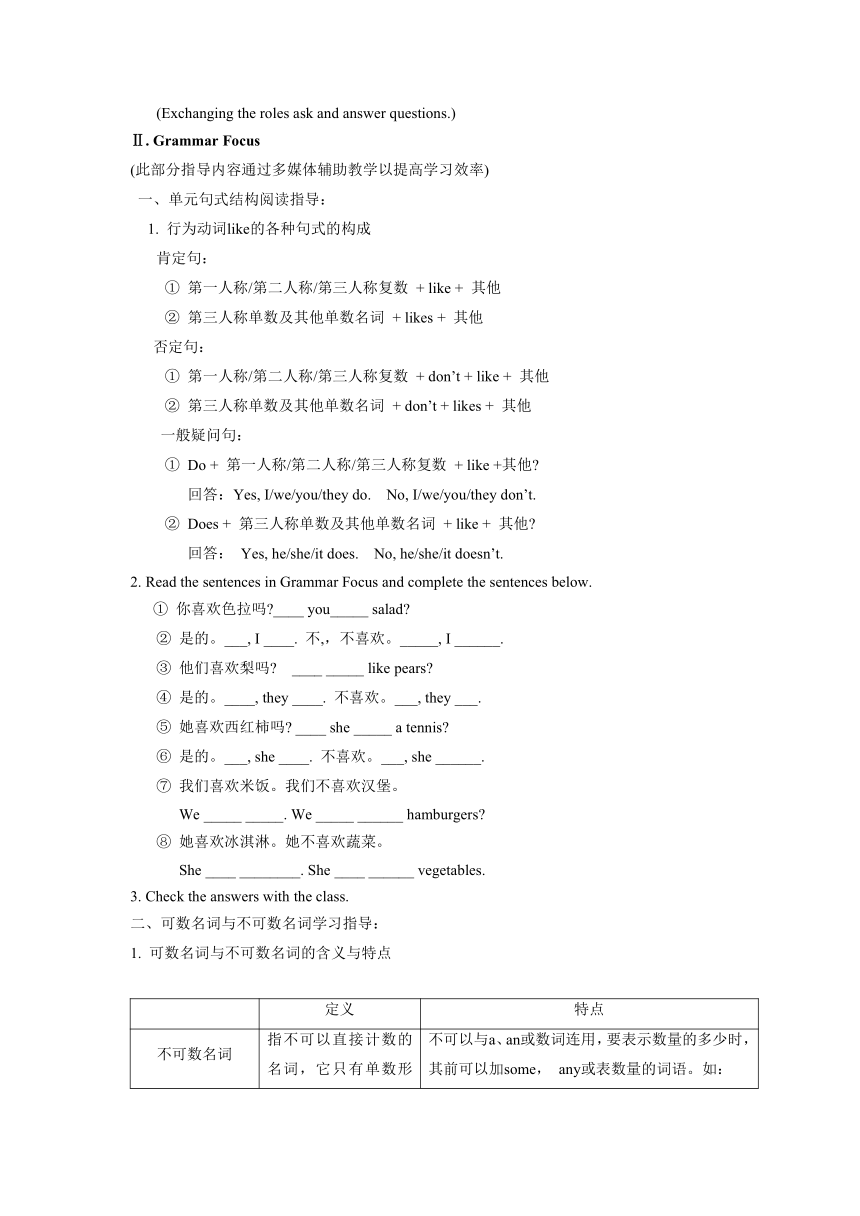Unit 6 Do you like bananas Section A 教学设计
文档属性
| 名称 | Unit 6 Do you like bananas Section A 教学设计 |  | |
| 格式 | zip | ||
| 文件大小 | 124.9KB | ||
| 资源类型 | 教案 | ||
| 版本资源 | 人教新目标(Go for it)版 | ||
| 科目 | 英语 | ||
| 更新时间 | 2017-07-31 09:20:01 | ||
图片预览


文档简介
Unit
6
Do
you
like
bananas
Section
A
教学设计
一、教学目标:
1.语言知识目标:
1)学习描述自己或他人喜欢或不喜欢的食物,能够用but来表达简单的句子。
2)总结动词like一般现在时的肯定句式、否定句式及一般疑问句的肯定、否定回答。3)
总结复习可数名词复数的知识。
4)理解英语可数名词与不可数名词的概念,并对所学过的部分词汇按此分类进行归纳总结。2.
情感态度价值观目标:
通过任务型活动,使学生学会在实际生活中均衡饮食,合理配餐;通过开展小组活动,指导学生积极与他人合作,培养他们的合作精神。
二、教学重难点
1.
教学重点:
1)总结动词like一般现在时的肯定句式、否定句式及一般疑问句的肯定、否定回答。
2)理解英语可数名词与不可数名词的概念,并对所学过的部分词汇按此分类进行归纳总结。
2.
教学难点:
理解英语可数名词与不可数名词的概念,并对所学过的部分词汇按此分类进行归纳总结。
三、教学过程
Ⅰ.
Warming-
up
and
revision
1.
Greeting
the
Ss.
Check
the
homework.
2.
Review
the
new
wo
( http: / / www.21cnjy.com )rds
about
food,
fruit
and
vegetables.
(Ss
may
look
at
the
picture
in
1a).
3.
Ask
and
answer.
(Ss
work
in
groups.
A
( http: / / www.21cnjy.com )sk
and
answer
about
the
questions
according
to
the
picture
in
1a.)
S1:
Do
you
like
bananas
S2:
Yes
I
do.
S3:
Does
he
like
bananas
S4:
Yes,
he
does.
S1:
Do
you
like
ice-cream
S2:
No,
I
don’t.
S3:
Does
he
like
ice-cream
S4:
No,
he
doesn’t.
(Exchanging
the
roles
ask
and
answer
questions.)
Ⅱ.
Grammar
Focus
(此部分指导内容通过多媒体辅助教学以提高学习效率)
一、单元句式结构阅读指导:
1.
行为动词like的各种句式的构成
肯定句:
①
第一人称/第二人称/第三人称复数
+
like
+
其他
②
第三人称单数及其他单数名词
+
likes
+
其他
否定句:
①
第一人称/第二人称/第三人称复数
+
don’t
+
like
+
其他
②
第三人称单数及其他单数名词
+
don’t
+
likes
+
其他
一般疑问句:
①
Do
+
第一人称/第二人称/第三人称复数
+
like
+其他
回答:Yes,
I/we/you/they
do.
No,
I/we/you/they
don’t.
②
Does
+
第三人称单数及其他单数名词
+
like
+
其他
回答:
Yes,
he/she/it
does.
No,
he/she/it
doesn’t.
2.
Read
the
sentences
( http: / / www.21cnjy.com )
in
Grammar
Focus
and
complete
the
sentences
below.
①
你喜欢色拉吗 ____
you_____
salad
②
是的。___,
I
____.
不,,不喜欢。_____,
I
______.
③
他们喜欢梨吗
____
_____
like
pears
④
是的。____,
they
____.
不喜欢。___,
they
___.
⑤
她喜欢西红柿吗
____
she
_____
a
tennis
⑥
是的。___,
she
____.
不喜欢。___,
she
______.
⑦
我们喜欢米饭。我们不喜欢汉堡。
We
_____
_____.
We
_____
______
hamburgers
⑧
她喜欢冰淇淋。她不喜欢蔬菜。
She
____
________.
She
____
______
vegetables.
3.
Check
the
answers
with
the
class.
二、可数名词与不可数名词学习指导:
1.
可数名词与不可数名词的含义与特点
定义
特点
不可数名词
指不可以直接计数的名词,它只有单数形式。
不可以与a、an或数词连用,要表示数量的多少时,其前可以加some,
any或表数量的词语。如:some
bread
一些面包a
cup
of
milk
一杯牛奶
可数名词
指可以用来计数的名词,它有单数和复数两种形式。
可以用a、an或具体的数词修饰。如:a
tomato
一个西红柿an
egg
一个鸡蛋two
pears
两个梨
既是可数名词又是不可数名词
有些词,既可用作可数名词,也可以用不可数名词,但意义却不同:如:
可数名词
不可数名词orange
橙子
橙汁chicken
小鸡
鸡肉food
各种食物
食物glass
玻璃杯;眼镜
玻璃
2.
可数名词复数的构成
构成方式
例词
规则变化
一般的直接加-s
book
→
bookscat
→
cats
以s.
x.
sh.
ch结尾的加-es
bus
→
buses
box
→
boxes
brush
→
brushes
(刷子)
watch
→watches
以“辅音字母+y”结尾,变y为i,
再加-es
family
→
families
strawberry
→
strawberries
以“f或fe”结尾,变f或fe为v,
再加-es
knife
→
knives
(小刀)leaf
→
leaves
(树叶)
以字母“o”结尾的有生命词,加-es;以字母“o”结尾的无生命词,加-s
tomato
→
tomatoes
photo
→
photos
Ⅲ.
Practice
1.
Let’s
work
( http: / / www.21cnjy.com )
on
3a.
Here
are
some
sentences.
Please
underline
the
correct
words
in
the
brackets.
2.
Ss
read
the
sent
( http: / / www.21cnjy.com )ences
and
underline
the
correct
words.
They
can
discuss
with
their
partners.
3.
Check
the
answers
and
let
some
Ss
say
the
grammar
rules.
(根据句子主语的人称和数来确定谓语动词或助动词的数)
Ⅴ.
Practice
1.
Look
at
the
se
( http: / / www.21cnjy.com )ntences
in
3b.
Number
the
sentences
[1-4]
to
make
a
conversation.
2.
Check
the
answers
and
let
Ss
practice
the
conversation.
Ⅵ.
Survey
1.
T:
Our
likes
a
( http: / / www.21cnjy.com )nd
dislikes
of
food
are
different.
Some
Ss
like
these
food
and
other
Ss
like
other
food.
Let’s
make
a
survey
of
our
likes
and
dislikes
about
food.
First,
look
at
the
chart
below
and
write
down
the
names
of
the
food.
Second,
ask
your
classmates
about
the
food
in
the
chart.
e.g.
You:
Do
you
like
ice-cream,
Liu
Li
Liu
Li:
Yes,
I
do.
You:
What
about
rice
Liu
Li:
No,
I
don’t.
…
You:
Do
you
like
ice-cream,
Zhao
Jun
Zhao
Jun:
No,
I
don’t.
Zhao
Jun:
What
about
rice
Zhao
Jun:
Yes.
I
like
rice.
2.
Fill
in
the
chart
with
the
names
of
your
classmates.
3.
Report
the
result
of
your
survey
likes
this:
Liu
Li
likes
ice-crea
( http: / / www.21cnjy.com )m,
but
she
doesn’t
like
rice.
Zhao
Jun
doesn’t
like
ice-cream
but
he
likes
rice.
…
Homework
1.
Review
the
Grammar
Focus.
2.
Write
the
report
of
your
survey
result
on
your
workbook.
6
Do
you
like
bananas
Section
A
教学设计
一、教学目标:
1.语言知识目标:
1)学习描述自己或他人喜欢或不喜欢的食物,能够用but来表达简单的句子。
2)总结动词like一般现在时的肯定句式、否定句式及一般疑问句的肯定、否定回答。3)
总结复习可数名词复数的知识。
4)理解英语可数名词与不可数名词的概念,并对所学过的部分词汇按此分类进行归纳总结。2.
情感态度价值观目标:
通过任务型活动,使学生学会在实际生活中均衡饮食,合理配餐;通过开展小组活动,指导学生积极与他人合作,培养他们的合作精神。
二、教学重难点
1.
教学重点:
1)总结动词like一般现在时的肯定句式、否定句式及一般疑问句的肯定、否定回答。
2)理解英语可数名词与不可数名词的概念,并对所学过的部分词汇按此分类进行归纳总结。
2.
教学难点:
理解英语可数名词与不可数名词的概念,并对所学过的部分词汇按此分类进行归纳总结。
三、教学过程
Ⅰ.
Warming-
up
and
revision
1.
Greeting
the
Ss.
Check
the
homework.
2.
Review
the
new
wo
( http: / / www.21cnjy.com )rds
about
food,
fruit
and
vegetables.
(Ss
may
look
at
the
picture
in
1a).
3.
Ask
and
answer.
(Ss
work
in
groups.
A
( http: / / www.21cnjy.com )sk
and
answer
about
the
questions
according
to
the
picture
in
1a.)
S1:
Do
you
like
bananas
S2:
Yes
I
do.
S3:
Does
he
like
bananas
S4:
Yes,
he
does.
S1:
Do
you
like
ice-cream
S2:
No,
I
don’t.
S3:
Does
he
like
ice-cream
S4:
No,
he
doesn’t.
(Exchanging
the
roles
ask
and
answer
questions.)
Ⅱ.
Grammar
Focus
(此部分指导内容通过多媒体辅助教学以提高学习效率)
一、单元句式结构阅读指导:
1.
行为动词like的各种句式的构成
肯定句:
①
第一人称/第二人称/第三人称复数
+
like
+
其他
②
第三人称单数及其他单数名词
+
likes
+
其他
否定句:
①
第一人称/第二人称/第三人称复数
+
don’t
+
like
+
其他
②
第三人称单数及其他单数名词
+
don’t
+
likes
+
其他
一般疑问句:
①
Do
+
第一人称/第二人称/第三人称复数
+
like
+其他
回答:Yes,
I/we/you/they
do.
No,
I/we/you/they
don’t.
②
Does
+
第三人称单数及其他单数名词
+
like
+
其他
回答:
Yes,
he/she/it
does.
No,
he/she/it
doesn’t.
2.
Read
the
sentences
( http: / / www.21cnjy.com )
in
Grammar
Focus
and
complete
the
sentences
below.
①
你喜欢色拉吗 ____
you_____
salad
②
是的。___,
I
____.
不,,不喜欢。_____,
I
______.
③
他们喜欢梨吗
____
_____
like
pears
④
是的。____,
they
____.
不喜欢。___,
they
___.
⑤
她喜欢西红柿吗
____
she
_____
a
tennis
⑥
是的。___,
she
____.
不喜欢。___,
she
______.
⑦
我们喜欢米饭。我们不喜欢汉堡。
We
_____
_____.
We
_____
______
hamburgers
⑧
她喜欢冰淇淋。她不喜欢蔬菜。
She
____
________.
She
____
______
vegetables.
3.
Check
the
answers
with
the
class.
二、可数名词与不可数名词学习指导:
1.
可数名词与不可数名词的含义与特点
定义
特点
不可数名词
指不可以直接计数的名词,它只有单数形式。
不可以与a、an或数词连用,要表示数量的多少时,其前可以加some,
any或表数量的词语。如:some
bread
一些面包a
cup
of
milk
一杯牛奶
可数名词
指可以用来计数的名词,它有单数和复数两种形式。
可以用a、an或具体的数词修饰。如:a
tomato
一个西红柿an
egg
一个鸡蛋two
pears
两个梨
既是可数名词又是不可数名词
有些词,既可用作可数名词,也可以用不可数名词,但意义却不同:如:
可数名词
不可数名词orange
橙子
橙汁chicken
小鸡
鸡肉food
各种食物
食物glass
玻璃杯;眼镜
玻璃
2.
可数名词复数的构成
构成方式
例词
规则变化
一般的直接加-s
book
→
bookscat
→
cats
以s.
x.
sh.
ch结尾的加-es
bus
→
buses
box
→
boxes
brush
→
brushes
(刷子)
watch
→watches
以“辅音字母+y”结尾,变y为i,
再加-es
family
→
families
strawberry
→
strawberries
以“f或fe”结尾,变f或fe为v,
再加-es
knife
→
knives
(小刀)leaf
→
leaves
(树叶)
以字母“o”结尾的有生命词,加-es;以字母“o”结尾的无生命词,加-s
tomato
→
tomatoes
photo
→
photos
Ⅲ.
Practice
1.
Let’s
work
( http: / / www.21cnjy.com )
on
3a.
Here
are
some
sentences.
Please
underline
the
correct
words
in
the
brackets.
2.
Ss
read
the
sent
( http: / / www.21cnjy.com )ences
and
underline
the
correct
words.
They
can
discuss
with
their
partners.
3.
Check
the
answers
and
let
some
Ss
say
the
grammar
rules.
(根据句子主语的人称和数来确定谓语动词或助动词的数)
Ⅴ.
Practice
1.
Look
at
the
se
( http: / / www.21cnjy.com )ntences
in
3b.
Number
the
sentences
[1-4]
to
make
a
conversation.
2.
Check
the
answers
and
let
Ss
practice
the
conversation.
Ⅵ.
Survey
1.
T:
Our
likes
a
( http: / / www.21cnjy.com )nd
dislikes
of
food
are
different.
Some
Ss
like
these
food
and
other
Ss
like
other
food.
Let’s
make
a
survey
of
our
likes
and
dislikes
about
food.
First,
look
at
the
chart
below
and
write
down
the
names
of
the
food.
Second,
ask
your
classmates
about
the
food
in
the
chart.
e.g.
You:
Do
you
like
ice-cream,
Liu
Li
Liu
Li:
Yes,
I
do.
You:
What
about
rice
Liu
Li:
No,
I
don’t.
…
You:
Do
you
like
ice-cream,
Zhao
Jun
Zhao
Jun:
No,
I
don’t.
Zhao
Jun:
What
about
rice
Zhao
Jun:
Yes.
I
like
rice.
2.
Fill
in
the
chart
with
the
names
of
your
classmates.
3.
Report
the
result
of
your
survey
likes
this:
Liu
Li
likes
ice-crea
( http: / / www.21cnjy.com )m,
but
she
doesn’t
like
rice.
Zhao
Jun
doesn’t
like
ice-cream
but
he
likes
rice.
…
Homework
1.
Review
the
Grammar
Focus.
2.
Write
the
report
of
your
survey
result
on
your
workbook.
同课章节目录
- starters 预备篇(2012秋审查)
- Unit 1 Good morning !
- Unit 2 What’s this in English?
- Unit 3 What color is it ?
- Unit 1 My name's Gina.
- Section A
- Section B
- Unit 2 This is my sister.
- Section A
- Section B
- Unit 3 Is this your pencil?
- Section A
- Section B
- Unit 4 Where's my schoolbag?
- Section A
- Section B
- Unit 5 Do you have a soccer ball?
- Section A
- Section B
- Unit 6 Do you like bananas?
- Section A
- Section B
- Unit 7 How much are these socks?
- Section A
- Section B
- Unit 8 When is your birthday?
- Section A
- Section B
- Unit 9 My favorite subject is science.
- Section A
- Section B
